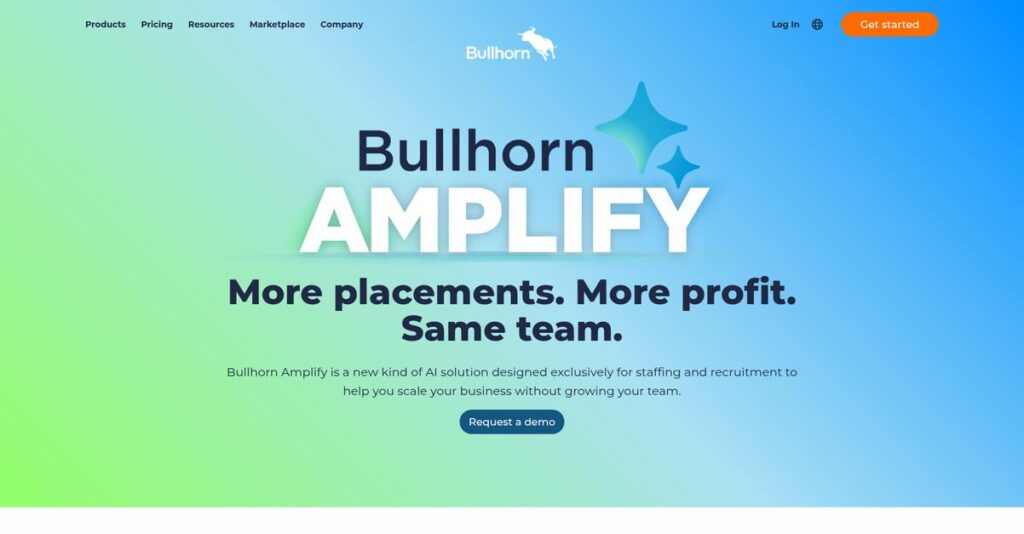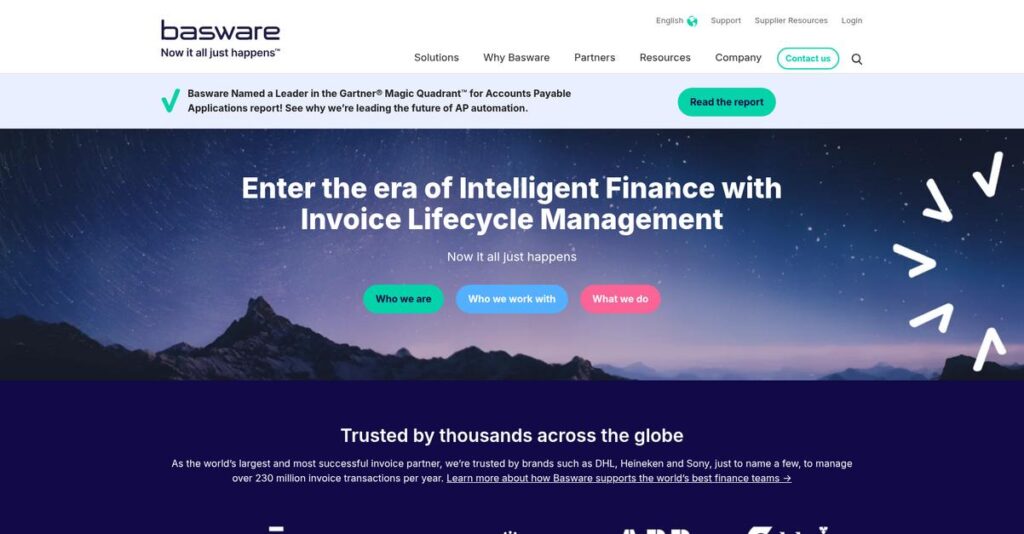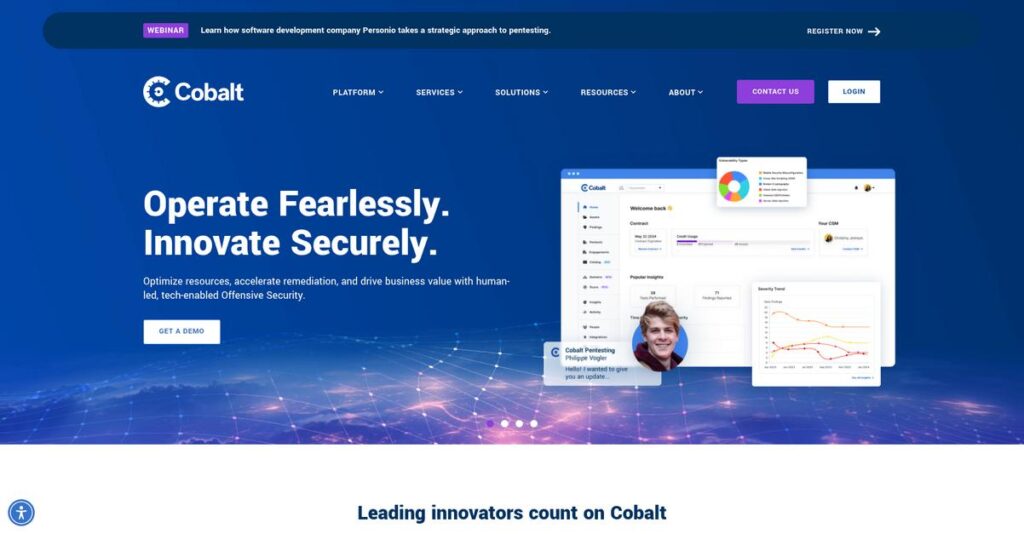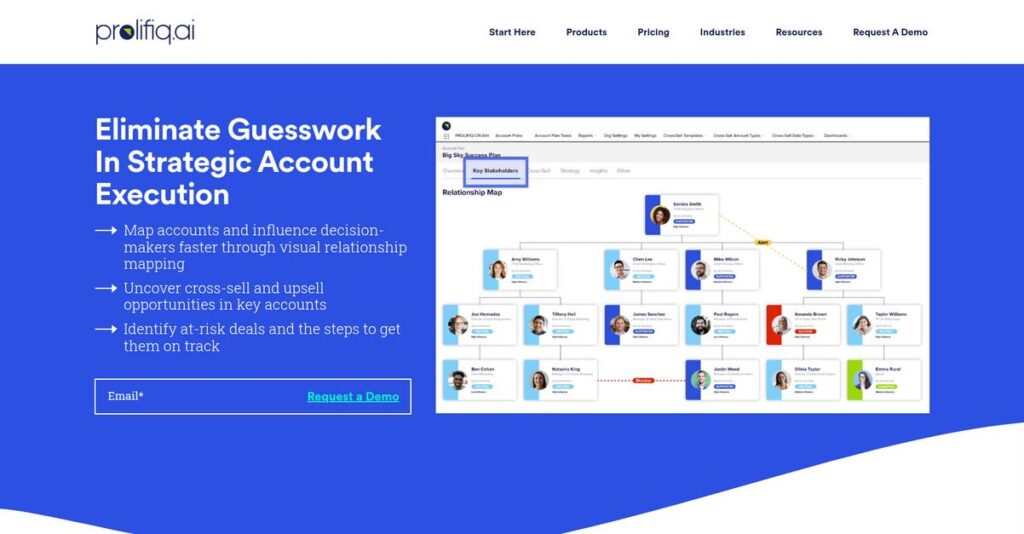Managing multiple recruiting tools wastes your time.
If you’re juggling separate systems for tracking jobs, clients, and candidates, it’s no wonder you’re frustrated searching for a better recruiting platform.
After researching Bullhorn’s capabilities, I actually established that disconnected processes slow your hiring and lose placements when you’re using pieced-together recruiting software.
Bullhorn tackles this head-on by unifying applicant tracking, CRM, automation, onboarding, analytics, and VMS integrations into one platform—letting you work from a single ecosystem rather than wrestling with data spread everywhere.
So in this Bullhorn review, I’ll show you how their all-in-one workflow really improves recruiting from end to end.
You’ll get the full story: real feature analysis, honest breakdowns of pricing, implementation hurdles, plus how Bullhorn stacks up versus JobDiva, Avionté, and alternative ATS options.
By the end, you’ll know the features you need to compare—and what to watch for—so you can choose with more confidence.
Let’s get started.
Quick Summary
- Bullhorn is a cloud-based staffing platform that unifies applicant tracking, CRM, and back-office operations in one system.
- Best for mid-to-large staffing agencies needing a configurable platform for managing recruiting and sales workflows.
- You’ll appreciate its integrated modules and automation options that reduce repetitive tasks and centralize your data.
- Bullhorn offers custom pricing based on needs, with no free trial but guided demos available through sales.
Bullhorn Overview
Bullhorn has been a key player in staffing software since 1999. Based in Boston, their mission is providing one cloud platform for the entire recruitment lifecycle, from sourcing to back-office.
Their specialization is what really stood out to me. They’re built specifically for staffing and recruiting agencies of all sizes, but particularly excel with mid-market and enterprise firms that need a truly robust system.
The acquisition of Herefish for automation was a smart move. In this Bullhorn review, you’ll see how it directly impacts recruiter productivity and candidate engagement in a positive way.
Unlike many competitors that can feel disjointed, Bullhorn’s real power comes from providing a truly unified ATS and CRM. This integrated approach feels like it was designed by people who actually do this work daily.
You’ll find them powering thousands of agencies globally. They’re a go-to for mid-sized firms up to large enterprises that need a highly configurable system to manage complex operations.
From what I’ve seen, their strategy is all about building out a complete ecosystem via smart acquisitions. This focus on automation and deep integration directly addresses your team’s need for greater efficiency.
- 🎯 Bonus Resource: While we’re discussing risk mitigation, understanding enterprise legal management software is equally important.
Now let’s examine their core capabilities.
Bullhorn Features
Managing your entire recruitment cycle is tough.
Bullhorn’s approach unifies the entire recruitment lifecycle. These Bullhorn solutions transform how agencies manage candidates and clients. Here are the five main Bullhorn solutions that solve critical staffing industry challenges.
1. Bullhorn ATS & CRM
Tired of juggling candidate data?
Separate systems for candidates and clients create frustrating data silos. This often leads to missed opportunities and wasted time trying to connect disjointed information.
This solution centralizes everything, from job orders to candidate pipelines and client communications. From my testing, emails and notes log automatically, which keeps all records updated without manual effort across your entire team.
You get a single source of truth, improving recruiter efficiency and ensuring no valuable data slips through the cracks.
2. Herefish by Bullhorn
Repetitive tasks slowing your recruiters down?
Recruiters spend too much time on manual follow-ups and candidate re-engagement. This pulls them away from high-value tasks like making placements and building client relationships.
Herefish automates these tasks with smart “if-then” workflows. What I found impressive is how it keeps your database warm by automatically sending timely emails and creating tasks for your team.
This means your team stays productive, candidate engagement improves, and your database becomes a consistently active asset, even for passive candidates.
- 🎯 Bonus Resource: Speaking of ensuring secure calls, my guide on best call blocking apps software might be helpful.
3. Bullhorn Onboarding
New hire paperwork a nightmare?
Manual onboarding processes are error-prone and administrative nightmares. This creates unnecessary delays for new hires and your internal staff, impacting productivity.
Bullhorn Onboarding streamlines pre-employment paperwork through a secure portal. It pre-populates forms and allows you to track completion status directly within Bullhorn, ensuring compliance.
You reduce administrative burden, ensure a smooth start for new hires, and gain complete visibility into their onboarding journey effortlessly.
4. Bullhorn Analytics
Need deeper insights into agency performance?
Relying on basic activity metrics hides the true performance picture. You can’t make informed decisions without deeper data insights into profitability and efficiency.
Bullhorn Analytics provides robust business intelligence for KPIs like time-to-fill and profitability. This is where Bullhorn shines, helping you identify bottlenecks or top performers by drilling into specific data.
You gain the clarity needed to optimize operations, improve recruiter efficiency, and make data-driven decisions that boost your agency’s bottom line.
5. Bullhorn VMS Access
Manual VMS data entry wasting hours?
Manually re-entering job requisitions from multiple VMS portals is a major drain. This leads to duplicate work and slower submission times for your recruiters.
VMS Access automates the transfer of job orders from various client VMS portals directly into your Bullhorn ATS. From my testing, it eliminates duplicate data entry by updating submissions automatically.
This frees up valuable recruiter time, drastically speeds up your submission process, and reduces errors across all your VMS accounts.
Pros & Cons
- ✅ Centralized platform for all recruitment data.
- ✅ Highly customizable to fit unique agency workflows.
- ✅ Powerful search and resume parsing capabilities.
- ⚠️ User interface can feel dated and clunky.
- ⚠️ Occasional performance issues and slow loading times.
- ⚠️ Additional costs for advanced features and add-ons.
What I love is how these Bullhorn solutions integrate to form a cohesive recruitment ecosystem. They work together to streamline every aspect of staffing, giving you unified data and workflows.
Bullhorn Pricing
Understanding software costs can feel complicated.
Bullhorn pricing is based on a custom-quote model, meaning you’ll need direct consultation for an exact figure tailored to your agency’s specific needs. This approach ensures your investment aligns perfectly.
Cost Breakdown
- Base Platform: Custom quote
- User Licenses: $100 to $220 per user, per month
- Implementation: A few thousand dollars to $10,000+
- Integrations: Varies by complexity based on add-ons
- Key Factors: Company size, specific products, user count, contract length, add-on modules
1. Pricing Model & Cost Factors
How does Bullhorn calculate costs?
Bullhorn operates on a custom, subscription-based model, where your total Bullhorn pricing is determined by your agency’s size, exact products, user count, and contract length. What I found regarding pricing is that add-on modules significantly influence your final spend, like Herefish or Bullhorn Analytics, alongside implementation fees. These factors mean tailored costs.
From my cost analysis, this approach helps your budget scale precisely with your operational requirements, preventing you from overpaying for unused features.
2. Value Assessment & ROI
Does Bullhorn offer strong ROI?
Bullhorn’s integrated suite offers significant value by unifying recruitment workflows, ultimately reducing manual effort and saving time. This approach, while a custom investment, means you avoid the costly data silos of disparate systems. What I found regarding pricing is that this integration creates substantial operational efficiencies, driving your team’s productivity. It’s an investment in streamlining your entire agency.
The result is your budget gets a robust solution that aims to accelerate placements and improve recruiter effectiveness compared to fragmented tools.
3. Budget Planning & Implementation
Plan your Bullhorn budget wisely.
Beyond the per-user fees and module costs, you must factor in implementation fees, which can range from thousands to over $10,000 for complex rollouts. Bullhorn does not offer a free trial, so anticipate guided demos for evaluation. Budget-wise, you should account for these upfront costs and potential training, impacting your initial total cost of ownership. These are critical.
So for your business, prepare for a notable initial investment, but one designed to pay dividends through improved efficiency and growth.
My Take: Bullhorn’s custom pricing emphasizes a tailored solution for mid-market to enterprise staffing agencies, ensuring you only pay for the specific features and scale your business truly requires for growth.
The overall Bullhorn pricing strategy prioritizes custom solutions for recruitment agencies, aligning costs with your specific operational needs. This means your investment provides precise value for your business. Contact sales to discuss your tailored quote.
Bullhorn Reviews
What do real Bullhorn users truly think?
Bullhorn reviews are extensive, offering deep insights into user experiences on platforms like G2 and Capterra. From my analysis, you’ll find a clear picture of what customers genuinely think about this recruiting software.
1. Overall User Satisfaction
Users often feel positive about it.
From my review analysis, Bullhorn generally maintains strong ratings, averaging around 4 out of 5 stars across over 1,500 reviews. What I observed is a consistent pattern of overall satisfaction, especially among agencies seeking an all-in-one solution. This widespread approval across various Bullhorn reviews suggests a reliable core experience.
This indicates its comprehensive approach, unifying diverse recruiting functions into a single source, significantly drives user contentment for staffing agencies.
2. Common Praise Points
Features users consistently praise.
Review-wise, users frequently commend Bullhorn as an all-in-one platform for recruitment operations, calling it a “single source of truth.” I also observed high praise for its robust configurability, allowing agencies to tailor workflows, and its powerful search capabilities for finding candidates.
- 🎯 Bonus Resource: Speaking of managing essential information, you might find my guide on best Android data recovery software helpful for unexpected data loss.
These strengths mean you get a highly adaptable system that centralizes your crucial data and streamlines candidate sourcing, boosting efficiency.
3. Frequent Complaints
What are the common user frustrations?
Despite its strengths, common Bullhorn reviews highlight several recurring pain points. What stands out is how users describe the UI as “clunky” and less intuitive, often requiring too many clicks. Additionally, I noted frequent mentions of performance issues like slowness and occasional lag, particularly in busy environments.
These issues, along with concerns about add-on costs and inconsistent support, suggest potential challenges for your team’s daily productivity.
What Customers Say
- Positive: “Bullhorn is a one-stop-shop for all things recruiting. It’s our single source of truth for candidate and client data.”
- Constructive: “The user interface is very clunky and not intuitive. It often takes too many clicks to get to a screen.”
- Bottom Line: “We have absolutely seen an ROI. In terms of efficiency and time saved, it’s definitely there, though hard to quantify.”
The overall Bullhorn reviews paint a picture of a powerful, comprehensive system, though one with notable usability and performance caveats. My analysis suggests user success hinges on feature prioritization and managing expectations around the UI.
Best Bullhorn Alternatives
Which recruitment platform truly fits your business?
The best Bullhorn alternatives include several strong options, each better suited for different business situations, priorities, and budget considerations. I’ll help you understand when other solutions might be a better fit.
1. JobDiva
Heavy VMS integration your top priority?
JobDiva excels if your firm heavily services VMS-based clients, offering robust automation for those specific workflows. From my competitive analysis, JobDiva provides superior VMS integration capabilities and patented search for large enterprises. This alternative offers high-volume automation.
Choose JobDiva when your business thrives on VMS client interactions and requires the most powerful, specialized automation for those needs.
- 🎯 Bonus Resource: Speaking of different software solutions, you might find my analysis of [patient case management software](https://nerdisa.com/best-patient-case-management-software/) helpful.
2. Crelate
Seeking a modern, flexible user experience?
Crelate stands out for its intuitive UI and high configurability, combining ATS, CRM, and contractor management. What I found comparing options is that Crelate offers impressive flexibility for mid-market firms seeking an all-in-one system without Bullhorn’s enterprise complexity. This alternative prioritizes user-friendliness.
You’ll want to consider Crelate if user experience is paramount and you need a highly adaptable system for your mid-sized agency.
3. Recruit CRM
Starting small, or simply prioritizing affordability?
Recruit CRM targets SMBs, offering simplicity, affordability, and excellent customer support. Alternative-wise, Recruit CRM provides essential features cost-effectively, ideal for agencies wanting a straightforward ATS/CRM without a steep learning curve or Bullhorn’s price tag.
For smaller agencies or startups, choose Recruit CRM if cost-effectiveness, simplicity, and core recruiting features are your top priorities.
Quick Decision Guide
- Choose Bullhorn: Robust, scalable platform for mid-to-large enterprise staffing agencies.
- Choose JobDiva: For large enterprises heavily reliant on VMS integrations and automation.
- Choose Crelate: When modern UI, flexibility, and mid-market fit are your key priorities.
- Choose Recruit CRM: Ideal for smaller agencies seeking cost-effective simplicity and core features.
The best Bullhorn alternatives choice depends on your specific business requirements and strategic focus rather than just feature lists. Consider your size, budget, and workflow priorities.
Setup & Implementation
Navigating Bullhorn implementation requires careful planning.
In this Bullhorn review, I’ll detail the deployment. Bullhorn implementation is a significant project, not plug-and-play. Expect a practical guide to the time, resources, and challenges you’ll face during setup.
1. Setup Complexity & Timeline
This isn’t a quick software flip.
From my implementation analysis, this process is complex, demanding careful planning. Your timeline can range from several weeks to a few months, depending on your scale and data complexity. Data migration is often a critical hurdle requiring Bullhorn’s assistance.
You’ll need a dedicated internal project manager to work with Bullhorn’s team. Plan thoroughly for your data migration strategy and workflow mapping upfront for a smoother implementation.
2. Technical Requirements & Integration
Expect some significant IT involvement.
Bullhorn is cloud-based, minimizing on-premise hardware. However, you’ll need to consider seamless integration with existing systems like accounting or payroll. What I found about deployment is that custom integrations often require developer resources, potentially adding complexity.
Ensure your IT team assesses current system compatibility and data exchange requirements early on. Budget for potential custom integration development or third-party connector services.
3. Training & Change Management
User adoption isn’t automatic.
Bullhorn’s extensive features and UI create a learning curve. Comprehensive user training is essential; a single session won’t suffice. What I found about implementation is that successful adoption hinges on ongoing programs and proactive change management, ensuring users fully embrace the system.
Invest in continuous training and develop user champions. Proactively address concerns, communicating benefits to drive successful adoption across your team.
4. Support & Success Factors
Good support is key during rollout.
Bullhorn’s implementation support quality varies; lower-tier plans often face slower ticket-based responses. Enterprise clients typically get dedicated reps. What I found about deployment is that proactive internal leadership is crucial for ensuring effective vendor communication and resolving challenges during your rollout.
Assign a clear internal lead to coordinate with Bullhorn support. Establish transparent communication channels and set realistic expectations for issue resolution.
Implementation Checklist
- Timeline: Weeks to several months, depending on scale
- Team Size: Dedicated project manager, IT, and core user team
- Budget: Professional services for data migration, custom integration, training
- Technical: Complex data migration, integration with existing systems
- Success Factor: Dedicated internal project management and comprehensive training
Overall, Bullhorn implementation requires significant planning and internal commitment. Approach it as a strategic project, not just a software install, to maximize your ROI and ensure long-term success.
Who’s Bullhorn For
Finding the right recruitment software is crucial.
This Bullhorn review analyzes who the platform serves best, providing clear guidance on business profiles, team sizes, and use cases. We’ll help you quickly determine if this software matches your situation.
1. Ideal User Profile
Established staffing and recruitment agencies.
From my user analysis, Bullhorn is ideal for established staffing and recruitment agencies needing a powerful, centralized platform. Your team of recruiters, sourcers, and account managers will find it excellent for managing complex workflows and unifying data. This software suits agencies outgrowing simpler tools.
You’ll see strong success if your priority is a robust, industry-standard system for comprehensive talent and client management across your operations.
- 🎯 Bonus Resource: While this review focuses on recruitment, if your business also spans diverse sectors, exploring automobile industry software can drive further sales growth.
2. Business Size & Scale
Scales best for mid-market and enterprise.
Bullhorn primarily serves mid-market and enterprise agencies with 20+ users looking to scale operations. Your team will benefit if you need deep customization, automation add-ons, and extensive reporting. What I found about target users is that smaller teams often find it overly complex.
You’ll know it’s a fit if you’re willing to invest significant time and resources into proper implementation and training.
3. Use Case Scenarios
Perfect for complex recruiting and sales workflows.
This software excels at managing complex recruiting and sales workflows, unifying the entire lifecycle from sourcing to back-office. User-wise, it’s a single source of truth for all candidate, client, and job data. The system shines for executive search and contract placements.
You’ll appreciate Bullhorn if you need powerful search, high configurability, and centralized management for complex operations across multiple teams or offices.
4. Who Should Look Elsewhere
Not for startups or simple needs.
Bullhorn may not be ideal if you’re a small startup, or a smaller agency with basic needs and a tight budget. Its user interface is often described as clunky, requiring many clicks. You’ll find simpler tools more intuitive.
Consider alternatives if you prioritize a modern, intuitive UI, a lower overall cost, or require very rapid customer support resolutions.
Best Fit Assessment
- Perfect For: Established staffing & recruitment agencies needing powerful centralization
- Business Size: Mid-market & enterprise agencies, 20+ users, outgrowing simpler tools
- Primary Use Case: Complex recruiting/sales workflows, candidate/client/job data unification
- Budget Range: Higher investment expected, not for tight budgets or startups
- Skip If: Small teams, basic needs, desire modern UI, or aversion to add-on costs
The answer to who should use Bullhorn centers on your operational scale and commitment to a powerful, centralized recruitment system. This Bullhorn review shows its best fit is established agencies seeking significant efficiency gains.
Bottom Line
Bullhorn: A powerful, specialized solution.
This Bullhorn review offers a deep dive into its capabilities, revealing a robust platform tailored for staffing agencies. My final assessment provides clear guidance on its overall value.
1. Overall Strengths
Industry-leading all-in-one capability.
Bullhorn excels by unifying the entire recruitment lifecycle, from sourcing to back-office. Its highly configurable nature allows agencies to tailor workflows, reducing reliance on multiple systems. From my comprehensive analysis, its robust search capabilities save recruiters time significantly, streamlining the candidate discovery process within their extensive database.
These strengths drive efficiency, create a single source of truth, and directly translate into productivity gains for your team.
2. Key Limitations
Interface and performance concerns.
Despite its power, Bullhorn’s user interface often feels dated and requires many clicks for simple tasks. Users also report occasional slowness, impacting daily workflow efficiency. Based on this review, costly add-ons increase the overall investment significantly, making some critical features feel less accessible.
These limitations are important considerations, but for businesses prioritizing comprehensive features, they are manageable tradeoffs.
3. Final Recommendation
A strong choice for specific agencies.
You should choose Bullhorn if your staffing or recruitment agency is a mid-market to enterprise-level operation requiring a highly scalable and configurable solution. My assessment shows it best serves those needing an integrated, comprehensive platform for the entire recruitment lifecycle without relying on multiple disparate systems.
My recommendation stands firm for the right fit; evaluate your specific needs before committing to its robust ecosystem.
Bottom Line
- Verdict: Recommended with reservations
- Best For: Mid-market to enterprise staffing and recruitment agencies
- Biggest Strength:T All-in-one platform for entire recruitment lifecycle
- Main Concern: Dated UI and potential performance issues
- Next Step: Request a tailored demo to assess fit
This Bullhorn review confirms significant value for dedicated recruitment firms, provided they are prepared to navigate its interface nuances for comprehensive capabilities.





